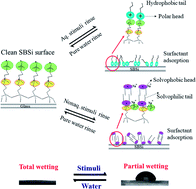当前位置:
X-MOL 学术
›
J. Mater. Chem. A
›
论文详情
Our official English website, www.x-mol.net, welcomes your
feedback! (Note: you will need to create a separate account there.)
Smart zwitterionic sulfobetaine silane surfaces with switchable wettability for aqueous/nonaqueous drops†
Journal of Materials Chemistry A ( IF 10.7 ) Pub Date : 2017-12-19 00:00:00 , DOI: 10.1039/c7ta09475b Vickramjeet Singh,Chun-Jen Huang,Yu-Jane Sheng,Heng-Kwong Tsao
Journal of Materials Chemistry A ( IF 10.7 ) Pub Date : 2017-12-19 00:00:00 , DOI: 10.1039/c7ta09475b Vickramjeet Singh,Chun-Jen Huang,Yu-Jane Sheng,Heng-Kwong Tsao

|
Smart surfaces with switchable wettability for both aqueous and non-aqueous drops based on zwitterionic sulfobetaine silane (SBSi) have been fabricated. The wettability transition occurs from a total wetting (contact angle, CA ≈ 0°) to a partial wetting (CA as high as ∼75°) state. A surfactant solution (aqueous or non-aqueous) rinse (for 5 s) acts as a stimulus and the reversal of surface wettability is achieved simply by a pure water rinse. The reversible behavior of the switchable wettability of a SBSi surface can be observed for at least 100 cycles. Various cationic surfactants are used as stimuli for aqueous drops and anionic surfactants are employed for non-aqueous drops. This unique wettability-switching property is attributed to basal surfactant adsorption driven by electrostatic attractions between the charged surfactant head groups and zwitterionic groups of SBSi. Such rapid surfactant adsorption is also responsible for intriguing drop fission and dewetting phenomena, shown by stimulus drops cast on clean SBSi surfaces. Thus, this smart switchable wettability surface can be employed to fabricate intelligent devices for controlling mobility and sensing.
中文翻译:

智能的两性离子磺基甜菜碱硅烷表面,具有可切换的润湿性,适用于水性/非水性液滴†
基于两性离子磺基甜菜碱硅烷(SBSi),已经制造出了可切换的水性和非水性液滴润湿性的智能表面。润湿性转变从完全润湿(接触角,CA≈0°)到部分润湿(CA高达〜75°)状态发生。表面活性剂溶液(水性或非水性)漂洗(持续5 s)起到刺激作用,表面润湿性的逆转仅通过纯水漂洗即可实现。至少100次循环后,即可观察到SBSi表面可切换润湿性的可逆行为。各种阳离子表面活性剂被用作水滴的刺激物,而阴离子表面活性剂被用作非水性滴剂。这种独特的润湿性转换特性归因于基础表面活性剂的吸附,它是由SBSi的带电表面活性剂头基和两性离子基团之间的静电吸引驱动的。这种快速的表面活性剂吸附还引起液滴的裂变和反润湿现象,这表现在干净的SBSi表面上的刺激液滴上。因此,该智能可切换润湿性表面可用于制造用于控制迁移率和感测的智能设备。
更新日期:2017-12-19
中文翻译:

智能的两性离子磺基甜菜碱硅烷表面,具有可切换的润湿性,适用于水性/非水性液滴†
基于两性离子磺基甜菜碱硅烷(SBSi),已经制造出了可切换的水性和非水性液滴润湿性的智能表面。润湿性转变从完全润湿(接触角,CA≈0°)到部分润湿(CA高达〜75°)状态发生。表面活性剂溶液(水性或非水性)漂洗(持续5 s)起到刺激作用,表面润湿性的逆转仅通过纯水漂洗即可实现。至少100次循环后,即可观察到SBSi表面可切换润湿性的可逆行为。各种阳离子表面活性剂被用作水滴的刺激物,而阴离子表面活性剂被用作非水性滴剂。这种独特的润湿性转换特性归因于基础表面活性剂的吸附,它是由SBSi的带电表面活性剂头基和两性离子基团之间的静电吸引驱动的。这种快速的表面活性剂吸附还引起液滴的裂变和反润湿现象,这表现在干净的SBSi表面上的刺激液滴上。因此,该智能可切换润湿性表面可用于制造用于控制迁移率和感测的智能设备。











































 京公网安备 11010802027423号
京公网安备 11010802027423号